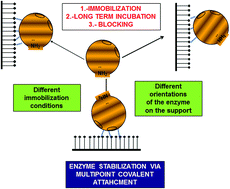Characterization of supports activated with divinyl sulfone as a tool to immobilize and stabilize enzymes via multipoint covalent attachment. Application to chymotrypsin
Abstract
Divinyl sulfone (DVS) has been used to activate agarose beads. The DVS activated agarose resulted quite stable in the pH range 5–10 at 25 °C under wet conditions, and can react rapidly with α-amides of Cys and His, at pH 5–10, with Lys mainly at pH 10 and with Tyr in a much slower fashion. After blocking with different nucleophiles, the support lost all reactivity, confirming that this protocol could be useful as an enzyme–support reaction end point. Then, chymotrypsin was immobilized on this support at pH 5, 7 and 10. Even though the enzyme was immobilized at all pH values, the immobilization rate decreased with the pH value. The effect of the immobilization on the activity depended on the immobilization pH, at pH 7 the activity decreased (to 50%) more than at pH 10 (by a 25%), while at pH 5 the immobilization has no effect. Then, the effect of blocking with different reagents was analyzed. It was found that blocking with ethylenediamine improved the enzyme activity by 70% and gave the best stability. The stability of all enzyme preparations improved when 24 h incubation was performed at pH 10, but the qualitative stabilization depended on the inactivation conditions. The analysis of the amino acids of the preparation immobilized at pH 10 showed that Lys, Tyr and Cys residues were involved in the immobilization, involving a minimum of 10 residues (glyoxyl agarose gave 4 Lys involved in the immobilization). The new preparation was 4–5 fold more stable than glyoxyl agarose preparation, considered a very stable one, and in some instances was more active than the free enzyme (170% for the enzyme immobilized at pH 10). Thus, DVS activated supports are very promising to permit the multipoint covalent attachment of enzymes, and that way to improve their stability.


 Please wait while we load your content...
Please wait while we load your content...